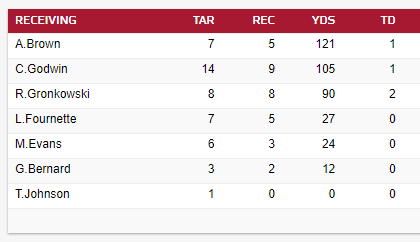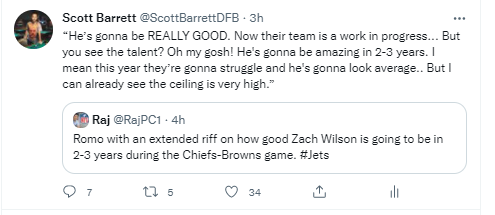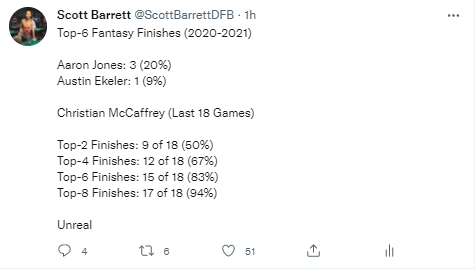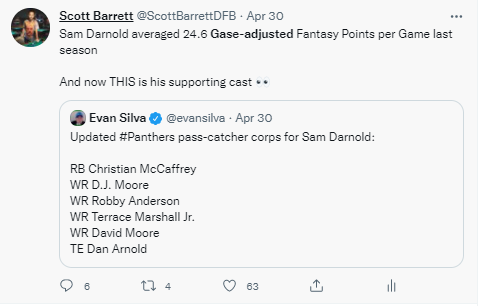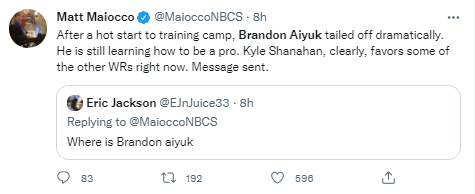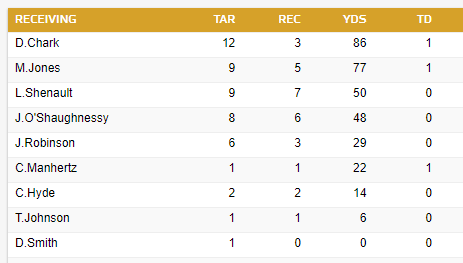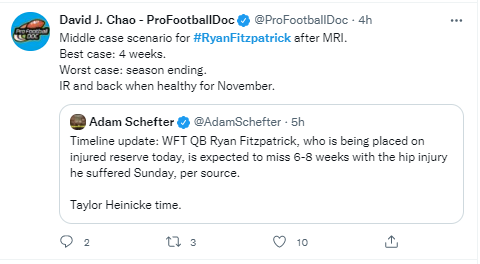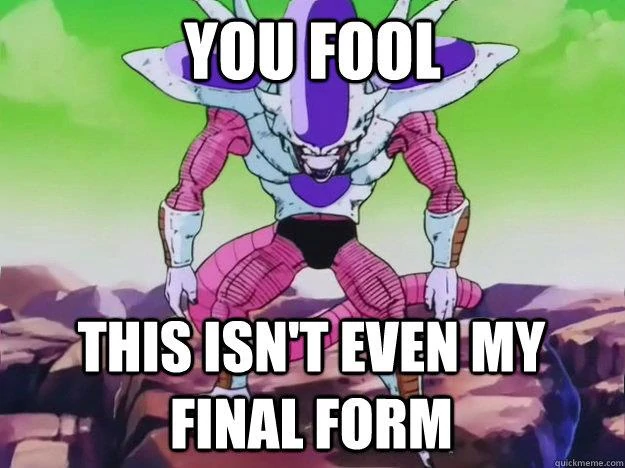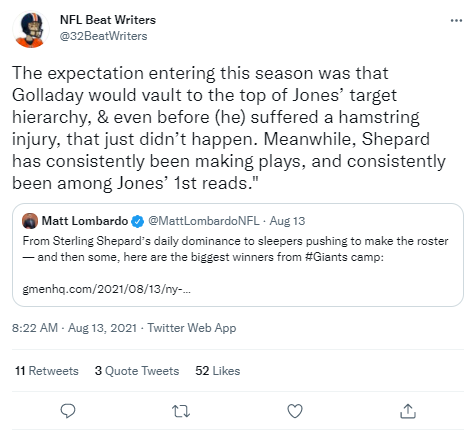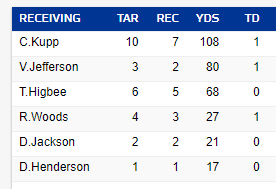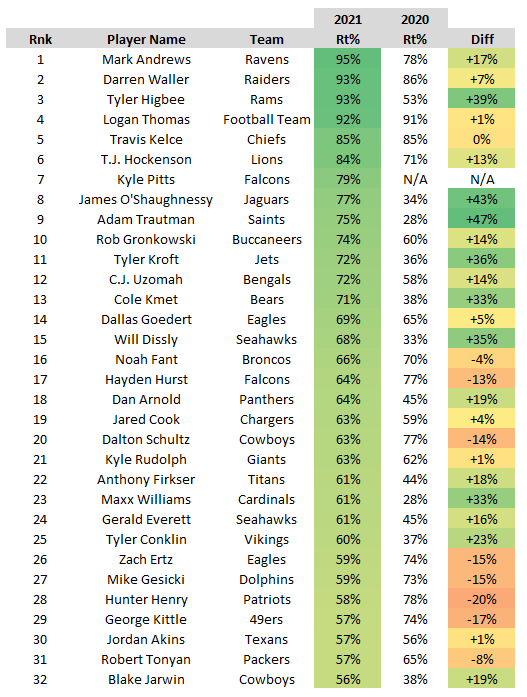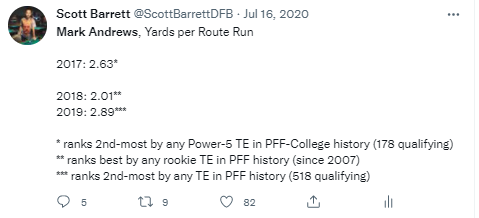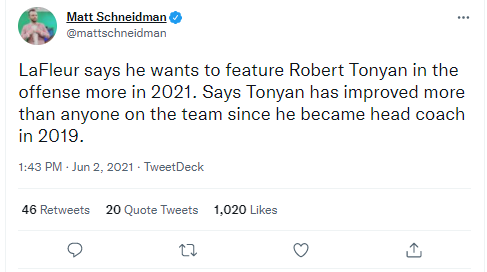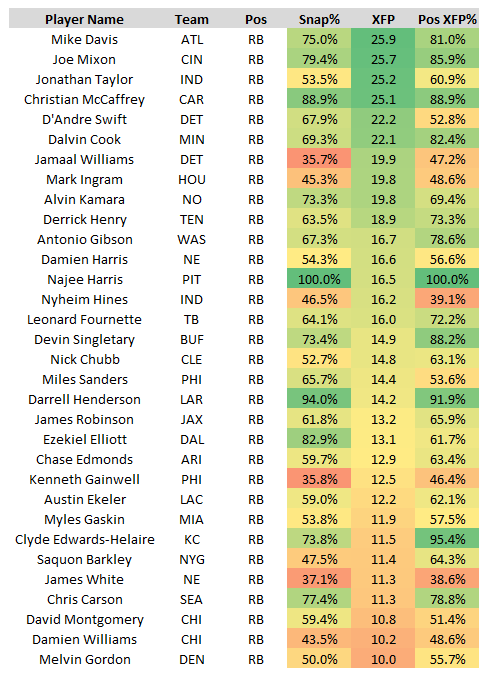Instead of today’s usual article on Expected Fantasy Points (XFP), we’ve decided to go above and beyond for Week 2.
In my experience, fantasy owners are typically too worried about overreacting to Week 1, and not worried enough about underreacting to Week 1. It’s important we don’t get misled by a one-game sample size, but at the same time, if you know what to look for, if you’re able to separate the signal from the noise, are proactive and quick to act, this could be the week where you lay the foundation for a future Championship victory. Today’s article is here to help… Here’s everything (seriously) you need to know from Week 1:
1. Tom Brady, Antonio Brown, and Rob Gronkowski look like the 2017 versions of Tom Brady, Antonio Brown, and Rob Gronkowski.
Chris Godwin led the receivers in route share, running a route on 100% of Tom Brady’s dropbacks. Mike Evans was right behind him (96%), followed by Gronkowski (74%) and then Brown (72%).
So, Brown isn’t quite a full-time player, but it also doesn’t seem to matter at all.
I had a difficult time ranking Tampa Bay’s wide receivers for fantasy, but Brown (as the cheapest of the three) was always the one I wanted the most exposure to. Here’s what I wrote in 96 Stats.
2A.Last season, from Week 10 (Antonio Brown’s second game back from suspension) through Week 17:
2B. Tom Brady averaged 23.2 FPG, hitting 20.0 fantasy points in 9 of 11 games.
2C. Brown actually led the team in targets per game over this span, tied with Mike Evans (8.1), and ahead of Chris Godwin’s 7.0.
2D. This preseason, Godwin has run 18 routes with Brady under center. Three more than Evans and Brown (15). But …
2E. .. Brown has clearly been Brady’s favorite target, averaging 0.40 targets per route, being targeted twice as often as Evans (0.20), and almost twice as often as Godwin (0.22).
2F. Evans and Godwin are both being drafted at the Round 3 / Round 4 turn, while Brown is going late-Round 7.
Over his last four regular season games, Brown now averages 8.8 targets and 25.1 DK FPG.
I wouldn’t worry too much about Evans. As Wes Huber tried to warn us, he easily had the toughest matchup of Tampa Bay’s wide receivers. Tampa Bay’s offense should continue to smash all year, but, undeniably, it’s going to be hard for him to justify his ADP (at the very least in contrast to Brown’s) with so many similarly imposing pass-catchers surrounding him.
Gronkowski ranked 10th among all TEs in route share on the week (74%), and is up from 61% over the second-half of last season. So, concerns over a potential committee alongside O.J. Howard and Cameron Brate appear to have been unfounded. He also looked great. It’s not unrealistic to think he takes a massive step forward this year, given the fact that he showed up out of shape last year after a year removed from football. Factor in the overall weakness of the TE position, his unreal chemistry with Brady, and the fact that he’s one of the best end zone weapons of all-time on a team that might lead the league in red zone drives, and he could prove to be one of the best values in 2021 drafts.
2. Dak is BACK.
In his first game back from a season-ending ankle injury, Prescott fell just three completions shy of an NFL record, going 42 of 58 for 403 yards, 3 touchdowns, and 1 interception.
Over the past two seasons, there have been only five instances of a QB reaching at least 450 passing yards. Three of those games were from Dak Prescott, who has played in just five full games over this span.
Over Prescott’s last four healthy games, he averages:
- 456.8 passing YPG (low of 403)
- 34.0 FPG (low of 28.4)
Over this span, Dallas averages 78.5 plays per game. For perspective, the Chargers led the league last year with 70.4.
Of course, these four games all came with mostly negative gamescripts. But good on OC Kellen Moore to do the smart thing, and freely abandon the run. It didn’t quite work out, but that’s the optimal strategy against a team like Tampa Bay. The Buccaneers have one of the most potent offenses in football and the league’s best run defense (by a margin). That’s why I’m not too worried about Ezekiel Elliott.
It’s not great that Tony Pollard out-targeted him 4 to 2, but Elliott still led the position in snaps (playing on 83% of the team’s snaps). So, he’s still definitely a bell cow. Remember, “total snaps” has a higher correlation to season-long fantasy points than “total touches.” He just saw a lot of empty snaps in a game where he was best utilized as a pass-blocker.
But yeah, Dak Prescott looked great, and healthy. It’s highly encouraging to see he picked up right where he left off. That’s great news for Amari Cooper and CeeDee Lamb, who both have easy WR1 upside in this potent and fast-paced offense.
Cooper averages 13.4 targets and 24.8 FPG over Prescott’s last five healthy games. He also seemed fully healthy, though there were concerns with his ankle heading into this game. He ended his day with 13 catches for 139 yards and two scores (16 targets).
Lamb averages 9.5 targets and 19.1 FPG over Prescott's last four healthy games. He ended Week 1 with 7 catches for 104 yards and a score (15 targets). He was less productive than Cooper in Week 1, but actually led the league in XFP with 31.9. (Cooper ranked 3rd with 29.0.)
Michael Gallup saw 7 targets (4-36-0) through three quarters of play before exiting early with an injury. He’ll be out 3-5 weeks with a calf strain.
3. Jalen Hurts is who I wanted him to be.
Hurts was my No. 1 Exodia play at the QB position for the entirety of the 2021 season. For reasons outlined here. And, from 96 Stats:
1A. Lamar Jackson averaged an astounding 135.2 rushing YPG in his final collegiate season. That ranks best among all QBs drafted in the first four rounds since 2014.
1B. Jalen Hurts ranks second (101.6), Kyler Murray ranks third (76.5), and Dak Prescott ranks fourth (57.8), though really both are a sizable distance behind Hurts.
1C. In any case, 2021 Hurts reminds me a lot of 2019 Lamar Jackson. Which is to say, he’s being drafted around his floor, and has massive league-winning upside in his sophomore season, thanks mostly to his hyper-mobility.
1D. Last season, Hurts averaged 24.8 fantasy points per four quarters (11.3 rushing). Or 25.9 FPG in games started and finished (9.9 rushing FPG). For perspective, 24.8 FPG would rank as the 8th-best QB season all-time and 25.9 FPG would rank 5th-best all-time. 11.3 rushing FPG would rank best all-time and 9.9 rushing FPG would rank 3rd-best since 1975.
1E. In other words, if Hurts remains who he was last year and doesn’t lose the starting job, he doesn’t just have high-end QB1 upside, he has overall QB1 and historically great levels of upside.
1F. And it’s not hard to envision an improvement. This is his first full season getting starter reps in practice, and his supporting cast will be much-improved following the healthy returns of a number of key starters, in addition to the arrival of Heisman Trophy winner DeVonta Smith.
1G. Due to a massive amount of injuries last year, Philadelphia's three most-targeted receivers last year were Greg Ward, Zach Ertz, and Travis Fulgham. Gross.
On Sunday, Hurts was unsurprisingly awesome from a fantasy perspective, scoring 28.8 fantasy points. But, more importantly he was awesome from a real-NFL-perspective, and incredibly efficient as a passer. On the week, Hurts ranked best in adjusted completion percentage (90%) and 2nd-best in PFF pass grade (87.9).
Including Sunday’s game, Hurts now averages 26.8 fantasy points per four quarters across his career. And 26.6 FPG in games started and finished. Either mark would rank 2nd-best by any QB in any season all-time, behind only Lamar Jackson’s 2019 season.
As I said earlier this offseason, Hurts doesn’t just have QB1 upside. He has high-end QB1-upside. Maybe the overall QB1, and historically great levels of upside.
Hurts has a massive guaranteed floor thanks to his hyper-mobility; a true fantasy cheat code. (Coming out of college he was the closest thing we’ve ever seen to Lamar Jackson.) But he didn’t lean too heavy on that aspect of his game on Sunday (just 6.2 fantasy points on the ground), and he didn’t need to.
And that’s another reason why I was so bullish. Even if Hurts was bad, he should still be great from a fantasy perspective. But what if he was actually, instead, really good?
And we should have expected a significant jump in passing production and efficiency. Philadelphia's three most-targeted receivers last year were Greg Ward, Zach Ertz, and Travis Fulgham. But on Sunday, we saw Devonta Smith lead the team with 19.1 fantasy points. Fellow first-rounder Jalen Reagor scored 16.9. And Dallas Goedert dropped 14.2.
4. Diontae Johnson gonna Diontae Johnson.
Last year, Diontae Johnson was benched for drops once and suffered an injury in the first half which caused him to spend time in the medical tent three times. In his other 12 games (postseason included), he averaged 12.3 targets, 19.6 XFP, and 19.4 FPG. For perspective, those numbers would have ranked best, 2nd-best, and 4th-best if over the full season. Over this span, he saw double-digit targets in 11 of 11 games Ben Roethlisberger played.
What happened in Week 1? Well, he again saw double-digit targets (10), earned a 31% target share (4th-best among WRs on the week), and was moderately productive, scoring 14.6 fantasy points.
But he also suffered an injury in the first half which caused him to spend time in the medical tent. That’s now happened four times (!) in 14 games (29%).
I want to believe that this is just some weird outlierish fluke, but I’ve said that before.
5. Bills RB Zack Moss demoted.
Moss was a surprise inactive in Week 1. RBs Devin Singletary, Matt Breida, and Taiwan Jones (who contributes mostly on special teams) were all active.
Yeah, so, he’s basically droppable. Devin Singletary looks a lot better in our rest-of-season rankings, but he’s still not too high on our radar. From 96 Stats:
2A. In each of the past three seasons Buffalo has ranked bottom-3 in team fantasy points scored at the RB position.
2B. Although a hyper-mobile QB might help boost a RB’s YPC, they rarely target their running backs. And can also cannibalize rushing upside with touchdown vultures.
2C. Buffalo’s RBs total just 179 receptions over the past three seasons, which ranks above only four other teams.
2D. Allen has 25 rushing touchdowns since entering the league, while the closest Buffalo RB has only 4 rushing touchdowns over the same span.
On Sunday, Singletary played on 73% of the team’s snaps (58 total, 2nd-most at the position), earning 11 of 15 carries (73%) and 5 of 5 targets out of the backfield.
Moss has now missed four games over the past two seasons. Over this span, Singletary averages 13.3 carries, 4.5 targets, 77.8 YFS, 0.25 touchdowns, and 12.5 FPG. He’s played on 77% of the team’s snaps in those games, which is great, but because Allen doesn’t target running backs and because Allen is also basically the team’s goal-line back, that severely caps Singletary’s upside. So, he’s just a high-end RB3 moving forward.
6. Jets WR Corey Davis picked up right where he left off.
From 96 Stats:
3A. This preseason, Corey Davis has run 14 routes with Zach Wilson under center. On those 14 routes, he totaled 88 yards (6.29 YPRR) on 10 targets (0.71 targets per route).
3B. For perspective, if this sort of usage carries over into the regular season (which it won’t) and he runs as many routes as he did last season, we should be projecting … 272 targets and 2,394 yards for Davis this season.
Davis was again Wilson’s favorite target, and highly productive. On a team-high 7 targets, Davis caught 5 for 97 yards and 2 scores.
DFB-favorite Elijah Moore, caught just 1 of 4 targets for -3 yards. Yeah, this was an absolutely brutal start to the #ElijahMooreSZN. Though, it’s worth noting, if we exclude plays negated due to penalty, Davis saw only one more target than Moore and only 14 more air yards. He had a 22-yard catch called back due to penalty, and was inches away from hauling in this 50-yard bomb.
I’m still extremely high on Moore, but I think I did underrate the significance of all the time he’s missed in camp (due to a quad injury). So, definitely don’t drop him. Just give him a few more weeks.
Though, also, I’m a lot less optimistic on New York’s offense as a whole. As Jets beat writers have warned us all offseason, they might have the worst offensive line in football. On Sunday, Wilson was sacked 5 times, hit 10 times, and was pressured on a league-high 51% of his dropbacks. And, keep in mind, LT Mekhi Becton played 75% of this game, but is now likely to be out multiple weeks with an apparent MCL sprain.
All in all, like beat writers have said all summer, Wilson looked good. But it’s hard to tell because of how bad this offensive line is. Tony Romo — who like me, can’t seem to stop gushing about him and his potential — agrees.
7. Christian McCaffrey picked up right where he left off.
From 96 Stats:
1A. Aaron Jones finished as a top-6 fantasy running back in just three games last year. Nick Chubb just twice. Austin Ekeler only once. Okay, so keep that in mind.
1B. Over his last 17 games, Christian McCaffrey has finished top-2 47% of the time, top-4 67% of the time, top-6 82% of the time, and top-8 94% of the time. So, just once he failed to finish top-8 (when he finished 14th).
What happened in Week 1? McCaffrey finished first at the position in fantasy points scored. McCaffrey didn’t even score a touchdown, and he still totaled 27.7 fantasy points.
21 carries, 9 targets, 9 catches, 187 YFS.
Built different.
McCaffrey led the team in targets (9), followed by D.J. Moore (8), Terrace Marshall (6), and Robby Anderson (3).
This offense supported three top-25 fantasy wide receivers last year, but McCaffrey returning to the mix muddies things a bit. Basically, it’s hard to imagine that repeating with McCaffrey commanding WR1-levels of target volume.
Still, Moore scored 14.0 fantasy points, and Anderson dropped 12.7 on just one catch. And Sam Darnold looked good and had 19.9 fantasy points in the first half, before OC Joe Brady asked him to take his foot off the gas.
8. Adam Thielen remains the heavy-favorite to have had the dumbest ADP in 2021 fantasy drafts.
From 96 Stats:
1A. Over the past four seasons, Adam Thielen has finished 11th, 7th, 44th, and (last year) 11th in FPG.
1B. That 2019 season looks rough, but Thielen was averaging 17.3 fantasy points per four quarters (would have ranked 7th-best), before suffering a hamstring injury on his 9th snap of the game in Week 6. He’d spend the remainder of the season inactive battling that injury, or playing part time and only as a decoy.
1C. And yet despite (essentially) four consecutive WR1 finishes, he’s just the 22nd most-expensive WR fantasy (ADP: Round 5). And that makes absolutely no sense at all.
And the touchdown regression narrative never seemed to make much sense when he averaged 1.33 end zone targets per game last year (2nd-most), and the team lost two big-bodied end zone weapons in Irv Smith and Kyle Rudolph.
Thielen saw a team-high 10 targets on Sunday, hauling in 9 for 92 and 2 touchdowns.
Justin Jefferson caught 5 of 9 for 71 yards and was millimeters away from a score.
9. Ja’Marr Chase: What, me worry?
Chase saw 5 targets this preseason. And he dropped 4 of them. Not good.
Week 1? He led the team in targets, catching 5 for 101 yards and a score. He also led the receivers in route share (94%), ahead of Tee Higgins (84%) and Tyler Boyd (84%). Very good.
It’s clear to see Burrow’s chemistry with Chase picked up right where it left off in 2019 (LSU). He was the WR1 on Sunday, and he might be the WR1 across the full season. We’ll see. At the very least, it was a phenomenal debut for an elite prospect a full year removed from playing football. Remember, according to my model, Chase ranks as the best WR prospect to come out since at least 2015. (And that was before a 98th-percentile showing at his Pro Day.)
10. Raheem Mostert gonna Raheem Mostert.
Mostert did the most Mostert thing possible on Sunday — he averaged 10.0 YPC and then sat out the remainder of the game (three full quarters) with a knee injury. He’s now out for the remainder of the season.
Trey Sermon was a surprise inactive. It’s possible this was just HC Kyle Shanahan trying to light a fire under his ass. Or, maybe, Elijah Mitchell and JaMycal Hasty didn’t significantly out play Sermon in camp. Maybe, at least, it was close, and Sermon was only inactive because he doesn’t play on special times (like Mitchell and Hasty both do). Maybe he’s going to smash for fantasy this week and beyond as the team’s RB1! Realistically, I’m more inclined to believe he’s just flat-out the team’s RB4 (now RB3), but if you own him, you have little choice but to hold and hope, telling yourself stories like this.
In Mostert’s absence, Elijah Mitchell rushed 19 times for 104 yards and a score (0 targets). JaMycal Hasty scored a 3-yard touchdown on his lone rush, while also gaining 15 yards on his lone target.
Mitchell is going to be the No. 1 waiver add of Week 2, and rightfully so. It feels like we can never know with any real certainty who is going to “be the guy” in Shanahan’s backfield, but we know, whoever that guy is, is going to smash for fantasy. And Mitchell is now the heavy favorite.
11. Brandon Aiyuk gets the Dante Pettis treatment.
Aiyuk ran a route on just 54% of his team’s dropbacks, and did not see a target.
Deebo Samuel picked up the slack, catching 9 of 12 targets for 189 yards and a score.
George Kittle caught 4 of 5 targets for 78 yards. Together, Samuel and Kittle combined for 72% of the team’s receptions and 84% of the team’s passing yards.
I’m not really too worried about Aiyuk. In fact, he’s a prime buy-low candidate. (And John Proctor tried to warn us about this.) Aiyuk wasn’t quite 100% coming back from a hamstring injury, and he missed extended time late in camp as they installed their Week 1 offense. So, it’s not surprising he saw a demotion in Week 1.
12. More fantasy potential in Detroit than was expected.
If T.J. Hockenson had the same role he had last year, he would have tanked teams who were drafting him at his ADP. There’s no way around it. From 96 Stats:
1A. Last season, Washington TE Logan Thomas led the position in routes run (609) and route-share (91%). That was well ahead of Lions TE T.J. Hockenson (461, 65%). Not to take anything away from Hockenson and his 2021 outlook, but…
1B. Hockenson was basically playing only three quarters of football per game to Thomas' four.
1C. That’s a massive handicap working against Hockenson for fantasy. I think that’s likely to change, but it will need to in order for him to pay off his lofty ADP (TE5, Round 5/6).
But, of course, Hockenson’s 2021 role appears far more valuable than the one he had last year. That’s what everyone expected, and it does appear to be the case.
Hockenson ran a route on 84% of Jared Goff’s dropbacks on Sunday, which ranked 6th-best among TEs. Further, he led the position with a team-high 11 targets, catching 8 for 97 yards and a score.
Jared Goff isn’t going to attempt 57 passes every game. That’s unrealistic. But at the same time, on a bottom-3 possibly-tanking Lions team, he might be the favorite to lead the league in pass attempts this year. And Hockenson really doesn’t have much target competition. Detroit’s leading receiver (non-RB) behind him was Kalif Raymon (a UDFA journeyman who has been on five different teams over the past six seasons) who gained 50 yards on 4 targets.
Detroit’s running backs also got heavily fed in this game, just as Graham Barfield predicted — former running back Anthony Lynn running the offense through his running backs.
Jamaal Williams finished as the RB3 on the week (25.0), while D’Andre Swift finished as the RB4 (24.4).
Despite reports that Swift would see a diminished role (due to a groin injury), he played on almost twice as many snaps as Williams, out-snapping him 57 to 30. And despite playing on 68% of the team’s snaps (12th-most), Swift ranked 3rd at the position in total snaps.
And, well, that’s the importance of pace. Anthony Lynn’s Chargers led the league in offensive snaps per game last year (70.4), and Lynn’s Lions led the league in offensive snaps in Week 1 (84). That’s massively important and massively valuable to Detroit’s players. And, negative gamescript isn’t too important for RBs if they’re going to be heavily involved in the pass game. Remember, outside of the red zone, a target is worth 3.1X as much as a carry for a RB in PPR leagues.
Among RBs, Swift (11) and Williams (9) ranked 1st and 2nd in targets on the week. Swift out-carried Williams, but Williams was more productive. Swift totaled 104 YFS and a score on 20 touches. Williams totaled 110 YFS and a score on 18 touches.
13. HC Urban Meyer might be a fake sharp. Better days ahead for James Robinson and D.J. Chark.
Jacksonville was an absolute mess in Week 1, losing 37-21 to a supposedly tanking Texans team.
Trevor Lawrence threw 51 times, completing just 28 for 332 yards, 3 touchdowns, and 3 interceptions. He ran once for -2 yards.
This preseason, James Robinson only barely out-snapped Carlos Hyde (33 to 28). In Week 1, Robinson out-snapped Hyde 46 to 25, but Hyde out-touched Robinson 11 to 8.
Still, that snap-total matters more to me than the touch total. Robinson should out-score Hyde this season, though I’m not high on either RB, and it wouldn’t surprise me if Hyde had more carries across the full-season. Robinson ran over twice as many routes as Hyde, out-targeting Hyde 6 to 2. But Hyde saw more volume and was more productive on the ground, gaining 44 yards on 9 carries versus Robinson’s 5 for 25.
I told my readers heading into Week 1 that I thought Marvin Jones’ odds of being the team’s WR1 was far better than ADP implied. But I take that back now after Chark led the team in targets (12, +3 more than next-closest) and air yards (196, +78 more than next-closest). Chark wasn’t too efficient with that good volume, but I think that’s understandable.
QB rapport isn’t something that develops overnight, and Chark was at a massive disadvantage, relative to the other receivers on the team, in this regard. He missed all of the team’s preseason games and months of practice time. So, his Week 1 volume is highly encouraging, and I suspect his efficiency and rapport with Lawrence will continue to improve as the season goes on.
14. Texans WR Brandin Cooks: an obvious high-floor value all offseason.
Cooks has finished top-17 in total fantasy points scored in five of his last six seasons, and on four different teams. From Week 5-on, last year, Cooks ranked 9th in targets (8.9), 3rd in YPG (92.0), and 4th in FPG (18.9). In games without Will Fuller, he averaged 22.5 FPG, which would have ranked 2nd-best. And, yet, he ranked just 40th by ADP.
Of course, losing QB Deshaun Watson was massive. But also, he has minimal competition for targets, and the ball has to go somewhere.
In a surprise victory, in which the Texans skewed very run-heavy, Cooks caught 5 of a team-high 7 targets (21%) for 132 yards. That’s his 3rd-straight game with at least as many receiving yards.
One of the most shocking stats from Week 1, however, was the fact that Mark Ingram, at age 31, was given a near-league-high 26 carries. He totaled 85 yards and a score on the ground, and failed to reel in his lone target of the day. Phillip Lindsay totaled 8-25-1 on the ground, and was also held catchless on 1 target. David Johnson went 3-10-0 on the ground and 2-18-1 through the air (on 4 targets).
I think Ingram probably never comes close to this sort of volume again, but this is basically the sort of split we should expect on a week-to-week-basis. Which is to say, Ingram and Lindsay split early down work 60/30, and Johnson handles about 80% of the targets out of the backfield. On a Texans team that shouldn’t be expected to win many more games, I think that makes Johnson the most valuable commodity for fantasy. But I also don’t think you’ll ever feel comfortable starting him unless all of your RBs are all on bye.
15. Russell Wilson was nearly perfect on Sunday, completing 18 of 23 for 254 yards, 4 scores, and 0 INTs.
Since 2010, only 10 times has a QB thrown for at least 250 yards and 4 touchdowns on fewer than 25 pass attempts. Wilson is the only QB to accomplish this feat more than once.
On just 5 targets apiece, Tyler Lockett and D.K. Metcalf scored 26.0 and 16.0 fantasy points, respectively.
Seattle’s new Shane Waldron-led offense was continually hyped up by Seattle’s players all offseason [1, 2], and it, clearly, did not disappoint on Sunday. Remember, in Anatomy of a League-Winner, we talked about the importance of not underrating the fantasy-impact a new play-caller can have for an offense. In Week 1, Waldron dialed up play-action on 41% of Russell Wilson’s dropbacks (2nd-most), up from 26% a season ago
Wilson was incredibly hyper-efficient on Sunday, but also unsustainably efficient. He’s due for a regression to the mean, but, then again, Wilson’s efficiency mean (that you’re regressing to) is always going to be a great deal higher than that of the average QB. Through nine NFL seasons, Russell Wilson has finished top-4 in fantasy points per dropback 6 times. That’s twice as many top-4 finishes as the next-closest QB over the same span.
Through his first eight games of the season last year, Wilson totaled 236.1 fantasy points (29.5 FPG) which is the 2nd-most by any QB through his first 8 games of a season all-time. Over this span, D.K. Metcalf ranked 2nd and Tyler Lockett ranked 3rd at the position in total fantasy points. That’s their upside when this offense is firing on all cylinders, like it was on Sunday.
Rashaad Penny saw just 2 touches before exiting the game with a calf injury. Even with that factored in, Chris Carson’s usage was highly encouraging, totaling 16 carries, 3 targets, and 117 YFS on a 78% snap share (6th-best). He should be viewed as nothing less than a high-end RB2 over the next few weeks with Penny out.
16. Jonathan Taylor and Nyheim Hines heavily targeted.
I had some concerns heading into the season that Indianapolis’ RBs wouldn’t see as much target-volume as they did last year with Philip Rivers under center. From, the 2021 Bell Cow Report:
Over the past three seasons, Philip Rivers has targeted running backs 27.1% of the time (2nd-most), while Carson Wentz targeted running backs only 17.4% of the time (28th of 40 qualifiers).
But those concerns seem to have been unfounded. Against Seattle’s bottom-5 CB corps, Wentz targeted his RBs (13) more often than he did his WRs (11). Taylor led the team in receiving yards (60) and Hines led the team in targets (8).
Jonathan Taylor went 17-56-0 on the ground and 6-60-0 through the air (on 7 targets). While Nyheim Hines posted lines of 9-34-0 and 6-48-0 (8 targets). So, this is definitely still a committee backfield, but it should be one of the most valuable backfields in fantasy. And Taylor, to me, looks a lot like the Aaron Jones of 2020. Which is to say, it was always frustrating to see him inexplicably capped at something like 60% of the team’s snaps. But because he was still heavily targeted, because he still dominated rushing work near the goal-line, and because he was a lock for 10-plus carries per game (more like 15-plus for Taylor), he should still be viewed as a RB1 for fantasy.
17. The Titans implode against a supposedly soft Cardinals defense.
By passer rating, this was Ryan Tannehill’s worst game since his first career start. Keep in mind, he played 24 games under Adam Gase.
By receiving yards, Julio Jones had his worst game since 2018.
Chester Rogers led the team in receiving yards, ahead of A.J. Brown.
Derrick Henry scored 10.7 fantasy points.
Yeah, Week 1 was rough for Titans fans.
Henry is easy to explain away. He’s long been the most gamescript-sensitive player in fantasy. Over his last 13 games that had an over/under of 50.0-points or more, Henry averages 30.7 FPG in wins (7), but just 9.1 FPG in losses (6). This game had an over/under above 50.0, but Tennessee didn’t win, and never came close.
As for everyone else, I’m not too sure. Vegas did think Tennessee overachieved last season, projecting them to win just 9 games this year, after winning 11 in 2020. I also had concerns that Arthur Smith was the true catalyst behind their recent success. But then again, Smith’s Falcons were even worse on Sunday.
Still, play-calling is definitely at least partially to blame. The Titans called play-action — an efficiency cheat code — on only 11.6% of Ryan Tannehill’s dropbacks in Week 1, down from a league-high 36.4% a season ago.
18. Kyler MVPurray?
Kyler Murray was awesome in Week 1, scoring a league-high 34.6 fantasy points. Like with Jalen Hurts, what was most impressive about this was that he barely used his legs. That’s his most potent weapon, his fantasy cheat code, and he didn’t even need to type in the Konami Code to post this monster score. Through the air, Murray scored 26.6 passing fantasy points, which ranked 3rd-most on the week.
I love Patrick Mahomes. He was my QB1 this season. But it never made much sense to me that he was being drafted two full rounds ahead of Murray. From 96 Stats:
1A. Kyler Murray ended the fantasy season (Weeks 1-16) as the overall QB1, averaging 25.8 FPG. That ranks 6th-best by any QB in any season all-time. His 9.8 FPG on the ground ranks 4th-most by any QB in any season since 1975.
1B. But his numbers look even more impressive if we adjust for a shoulder injury suffered in Week 9.
1C. After the injury, Murray averaged just 18.8 FPG and 5.7 rushing FPG.
1D. Before the injury (Weeks 1-9), Murray averaged 30.1 FPG and 12.8 rushing FPG.
1E. For perspective, both early-season marks would be NFL records, easily beating Lamar Jackson’s 27.7 FPG and 10.8 rushing FPG, both set in 2019.
1F. On average, he’s being drafted two full rounds behind Patrick Mahomes.
Finishing as the overall QB1? An MVP-winning season? The most FPG by any QB in any season in NFL history? That’s all within Murray’s range of outcomes.
P.S. I found it highly encouraging that DeAndre Hopkins can still move like this.
19. Fantasy Fact (Not Fiction): Mike Williams to see a bigger role in 2021.
From Underrated Upside: Wide Receivers:
Ideally, [Mike] Williams will benefit from the best QB play of his career — sophomore QB Justin Herbert ranks 6th by ADP and 9th by MVP odds. It’s hard to imagine Herbert justifies those odds without supporting multiple receivers as fantasy mainstays. And [Williams] should see the best target volume of his career, with Hunter Henry leaving behind 93 targets, and OC Joe Lombardi promising he’ll be a focal point (rather than the afterthought he’s long been) of the offense. Lombardi said in June, “As much as this offense will resemble New Orleans, [Williams] plays the ‘X’ and the ball has always kind of found the ‘X’ receiver in this offense. I think that there will be some natural production that comes his way because of the nature of the offense… I see a big role for him. If I were a betting man, I’d bet on nice numbers coming from him on the stat sheet, that’s for sure.”
Lombardi tried to tell us Williams would see a massive increase in usage in 2021, and no one wanted to believe him (ADP: WR47). But that’s exactly what we saw in Week 1.
Keenan Allen saw a Keenan Allen-like 13 targets (28%), catching 9 for 100 yards. But Williams also saw an Allen-like 12 targets (26%), catching 8 for 82 yards and a score.
This was the 2nd-most targets Williams has seen in his 57-game career, and just the fourth time he’s hit double-digit targets. I’d feel confident starting Williams as a WR3 or better in Week 2, especially against Dallas’ inept secondary.
But, of course, Austin Ekeler didn’t see a single target in Week 1, and that probably helped pad Williams’ numbers. And that’s also something that’s not likely to happen again. If you’re an Ekeler owner I wouldn’t be too worried. Ekeler barely practiced coming into Week 1 with a hamstring injury, and that's something that's going to limit him most in open space. So it's not surprising to me that he saw reduced involvement in the pass game. The bigger takeaway for me, however, is that he saw two carries inside the five-yard-line — he had only two such carries all of last year.
20. Ryan Fitzpatrick out multiple weeks. Antonio Gibson saw good usage. Terry McLaurin and Logan Thomas did not.
QB Ryan Fitzpatrick is out for 6-8 weeks, and potentially all year, with a hip injury.
Yeah, this is fairly unideal. A big reason we were so excited about McLaurin and Thomas was because we were anticipating a massive improvement in QB-play.
Like we saw last week (though they lost), expect Washington to lean sloth-paced and run-heavy, happy to beat teams with their defense. Washington threw just 21 times last week. McLaurin scored 10.2 fantasy points but on only 4 targets. Thomas scored 12.0 on just 3 targets.
Like we expected, Gibson’s snap-share wasn’t very high (67%, 13th-most), but his volume was excellent. He totaled 107 YFS, handling 20 of 23 carries and 5 of 7 targets out of the backfield. (His 24% target share ranked behind only Christian McCaffrey among RBs in Week 1.) That sort of volume is rare; there were only 24 instances of a RB earning 20+ carries and 5+ targets in a single game last year, so that happened only about 1.5 times per week.
I was dangerously high on Gibson all offseason, ranking him as my RB6 in PPR leagues, tied with Joe Mixon (the only tie in my rankings). I’m still very optimistic Gibson justifies that ranking, but, unfortunately, I still don’t yet know if I’d rather have him or Mixon.
21. From a fantasy-perspective, Tyreek Hill has massive, nearly unrivaled (think Jerry Rice, Christian McCaffrey) levels of upside. His upside is so massive that, by the end of the year, it could feel nearly impossible to have won your league without him.
From 96 Stats:
3A. If stripping out just two games Tyreek Hill exited early due to injury…
3B. Over the past four seasons, Hill has finished: 2nd (21.9), 3rd (18.4), 3rd (20.9), and, in 2017, 4th by FPG (16.3).
3C. But this isn’t even his final form.
3D. Over this span, Hill ranks just 16th among all receivers in targets per game, with 8.0. For perspective, that’s less than Zach Ertz (8.4) and Jarvis Landry (8.7). And well behind names like Antonio Brown (10.6), DeAndre Hopkins (10.4), Davante Adams (10.2).
3E. Any extra target volume would go a long way. Hill ranks behind only A.J. Brown in fantasy points per target over this span (2.35). And well above names like Keenan Allen (1.77) and Jarvis Landry (1.64).
Hill has historically always performed like a top-5 fantasy WR, but on only high-end WR2-levels of volume. However, there was a 6-game stretch last year, at the tail-end of the season right before he suffered a hamstring injury, where Hill averaged an Adams-like 12.3 targets and an astounding 30.9 DK FPG (would rank best by any WR in any season all-time).
What happened in Week 1? Hill saw 15 targets (3rd-most in his 75-game career), catching 11 for 197 yards and a score, good for 36.7 fantasy points. So now, over his last 7 healthy games, Hill averages:
- 12.7 targets per game
- 30.5 FPG
- 32.2 DK FPG
- 25-plus fantasy points in 5 of 7 games
- double-digit targets in 6 of 7 games
- 3 of his (career) 5 most-targeted games have come over this stretch
Of course, Travis Kelce was productive as well, catching 6 of 7 targets for 76 yards and 2 scores (25.6 fantasy points). This offense seems to be as highly concentrated as it was last year, running almost entirely through Hill and Kelce. Together they combined for 81% of Patrick Mahomes’ 337 passing yards. Sorry Mecole Hardman-truthers!
Though, Hardman did see an expanded role. His route share jumped from 49% last year to 83% in Week 1. View him as a slightly richer man’s 2020 Sammy Watkins.
22. Damien Harris: potential sell-high candidate.
I think next week — after a pillow-soft matchup against the Jets, but before much tougher draws against New Orleans (Week 3) and Tampa Bay (Week 4) — would be an ideal time to sell-high on Damien Harris. His numbers were excellent in Week 1, but I think it’s only a matter of time until Rhamondre Stevenson forces a 3-way committee.
Here’s what I said earlier in the offseason:
Damien Harris played on 8 of the team’s 12 first-string snaps. James White was on the field for the missing (four) snaps. Sony Michel managed just 26 yards on 6 carries with the second-string offense. Given this usage, and with Rex Burkhead now in Houston (though there’s a chance he gets cut and brought back to New England), I’m expecting New England’s backfield to look a lot like it did in 2016. That year, LeGarrette Blount handled 73% of the team’s carries out of the backfield, while White handled 68% of the targets out of the backfield. On this 14-win team, Blount ranked ninth in fantasy points scored (14.7 FPG) and White ranked 26th (10.1 FPG). Obviously, the overall offensive environment in New England isn’t anywhere near as attractive now as it was back then, but there’s some value here. Both are excellent selections in best ball leagues, and great options in DFS (Harris when New England is heavily favored, White if the Patriots are underdogs) but less so in start/sit leagues, due to a lack of week-to-week consistency.
It’s looking like the Harris show in New England, but rookie Rhamondre Stevenson might be breathing down his neck sooner or later.
I’m no longer so confident Harris gets Blount-type usage in 2021. I think his usage much more closely resembles his usage last year, with Stevenson playing the Michel-role (at worst).
After a stellar preseason — 30-216-5 on the ground, 4-3-25-0 through the air — Stevenson appeared to have forced his way into a committee. To open the game, Harris and Stevenson were tied with two touches apiece… But Stevenson (perhaps due to a dislocated thumb) fumbled on his second touch, and was then given the Stevan Ridley-treatment, kept under lock and key in HC Bill Belichick’s doghouse, and didn’t touch the ball again for the remainder of the game.
Harris ended his day with 100 rushing yards on 23 carries, while adding 2 catches for 17 yards on 3 targets through the air. But, Harris also fumbled in this contest, potentially costing his team a victory. Per ESPN’s Mike Reiss, he "looked fatigued shortly before the play in which he fumbled."
Anyway, I think after Week 2, Harris’ numbers will make him look a lot better than he’s actually worth. And Stevenson is worth stashing in deeper leagues.
23. In Sean Payton we trust! Jameis Winston throws 5 touchdowns.
Winston completed 14 of 20 throws for 148 yards, 5 touchdowns, and 0 interceptions. On the ground he gained 37 yards on 6 rushing attempts. In total, he scored 29.6 fantasy points, good for QB4 on the week.
Of course, a 25% TD-rate is not at all sustainable, but, the bigger takeaway was that Winston looked great. And New Orleans’ offense was roaring, even without WR Michael Thomas. And I don’t think this should have been too shocking. Here’s what we had to say in Underrated Upside: Quarterbacks:
Either one — whoever is inevitably named the starter — has massive upside, and they’re both cheap enough to make it easy and worthwhile to grab both.
Winston ranked 7th in fantasy points per start in 2019 (21.0) and 10th in 2018 (20.5). It’s hard to imagine the hyper-aggressive Winston won’t be able to find success in a Sean Payton offense. And it’s even possible he could be an improvement on a 41-year-old somewhat noodle-armed Drew Brees — both in terms of what he can open up for the offense and for what he can bring to your fantasy team.
And Brees was certainly no fantasy slouch, even in the twilight of his career. If excluding just two games Brees exited early due to injury, he would have finished 13th (18.4), 2nd (22.4) and 7th (20.3) in FPG over the past three seasons. And Teddy Bridgewater ranked as the QB12 across the five games he started in 2019, averaging 17.1 FPG. All of this makes me feel like Winston is a lock for QB1 production for however long he remains the starter.
On Sunday, Alvin Kamara saw 20 carries for just the 2nd time in his career. Of course, he only saw 4 targets, but that’s not too worrying considering Winston only threw the ball 20 times. (His 19% target share ranked 4th-best among RBs on the week.)
Tony Jones played the Latavius Murray role, gaining 53 YFS on 11 carries and 1 target.
24. Green Bay was awful.
Green Bay was an abject disaster on Sunday, but I don’t really have a good explanation for why.
Perhaps Rodgers’ decision to sit out most of training camp hurt him more than he thought it would, and he was understandably a little rusty. Perhaps Rodgers simply overachieved in 2020 — he led the league in passer rating in 2020 (121.5), but ranked just 14th over the prior three seasons (96.6). (His 36.8 passer rating ranked worst of Week 1.) Or maybe it's just variance; a random down-game in a 17-game sample.
We’ll see.
25. Jerry Jeudy looked awesome prior to injury.
Jeudy suffered a high-ankle sprain which will keep him off the field for 4-6 weeks. But it’s at least encouraging that he looked dominant prior to that injury.
Jeudy’s injury came early in the third quarter, capping him at just 47% of the team’s total snaps. But he still walked away with a team-high 72 yards, catching 6 of 7 targets. He also ran 78% of his routes from the slot, up from 30% a season ago. That’s also encouraging, as that’s his natural position.
Saban makes it clear at the end, that - though Jeudy is also capable on the outside - he prefers him in the slot. Though, that will most certainly be KJ Hamler's role in Denver. https://t.co/14p9N99NZk
— Scott Barrett (@ScottBarrettDFB) April 28, 2020
The sophomore year breakout we were all anticipating still feels like an inevitability. He just needs to get healthy.
26. Sterling Shepard, the forgotten man.
Shepard was neglected in fantasy drafts all offseason (ADP: WR63), and that was always a mistake. Especially with all of Evan Engram, Kyle Rudolph, Kenny Golladay, and Kadarius Toney banged up and missing a significant portion of training camp.
Despite being drafted (on average) 7.5 rounds behind Kenny Golladay, I’d take the odds on Shepard out-scoring him and leading the team in targets this year.
He caught 7 of 9 targets for 113 yards and a score. He's now scored at least 22.0 fantasy points in each of his last three games, and averages 8.1 targets per game over his last 11.
Golladay caught 4 of 6 for 63 yards, but was also out-targeted (7) and out-gained (65) by Darius Slayton.
27. Matthew Stafford, unsurprisingly, looked great. Cooper Kupp looked like his go-to guy. Buy Tyler Higbee? Sell Robert Woods?
In his first game with the Rams, Matthew Stafford recorded the highest passer rating of his 166-game career (156.1).
From 96 Stats:
1A. Just two years ago, Rams HC Sean McVay was still being heralded as the greatest offensive mind in football.
1B. His QB, Jared Goff, was 24-7 through two seasons, ranking behind only Patrick Mahomes and Drew Brees in ANY/A (7.70), and had finished as a fantasy QB1 in back-to-back seasons.
1C. The following year Goff led the league in pass attempts (626).
1D. The following year — this offseason — McVay felt the difference between Stafford and Goff was worth two first-round picks and a third.
1E. Who am I to disagree?
1F. Stafford finished 4th in FPG in 2019 (20.8), but the team struggled through a plague of injuries (including some of his own) last year. Now, he'll be playing alongside the most competent play-caller and the greatest supporting cast of his career.
1G. Stafford ranks 4th in MVP odds (+1200), but ranks 10th among QBs by ADP.
Stafford was awesome. And WR Cooper Kupp looked like the team’s clear WR1. He saw a team-high 10 targets (+4 more than next-closest), catching 7 for 108 yards and a score.
Again, 96 Stats:
3A. Robert Woods is being drafted as the WR13 (Round 3), while Cooper Kupp is being drafted as the WR17 (Round 4) …
3B. … even though Kupp has averaged more targets per game than Woods in each of the past two seasons and has averaged more FPG than Woods in two of the last three seasons.
Kupp was the better value in fantasy drafts, but I’d actually start to worry about Woods. He saw just 4 targets, catching 3 for 27 and a score. But more importantly, he ran just 18 routes on the day. Kupp ran 27. Van Jefferson ran 23. This could just be typical Sean McVay-shenanigans (their specific Week 1 matchup dictated this sort of usage but that won’t be the case every week), and he’ll go back to a full workload next week and beyond. But still, this isn’t what you want to see from a guy you drafted in Round 3.
Tyler Higbee might be my No. 1 trade target following Week 1. Again, it could just be Sean McVay-shenanigans, but he led all Week 1 TEs in route share (96%), up from 53% in 2020 (31st). And his 24% target share ranked 3rd-best among TEs on the week.
Higbee was always one of the best “Upside Wins Championships” picks in fantasy drafts, and I’m now far more optimistic that Higbee reaches his massive bull-case expectation. From Underrated Upside: Tight Ends:
Higbee really might be the ultimate “Upside Wins Championships” litmus test.
I’d say the odds aren’t very good Higbee will be a TE1 you’ll feel comfortable starting each week. But if he hits, he can hit big. Here’s the stat everyone wants to focus on:
Over the past four seasons, TE Gerald Everett — now in Seattle — dealt with only one serious injury which caused him to miss time. This occurred at the tail-end of the 2019 season, when Everett played a total of four snaps across five games (Weeks 13-17). Over this span, Higbee led the league in receiving yards (522), exceeding 100 yards in four of five games. His 11.2 targets per game and 21.4 FPG weren’t just the most by any tight end over this stretch, but they were the most by any tight end over any five-game stretch that season.
If Higbee puts up those kinds of numbers this year, at a Round 10 ADP (TE10), there’s no way he doesn’t finish as one of the top-3 most valuable players in fantasy. But of course, if he is who he was when Everett was healthy (maybe rookie TE Jacob Harris or second-year man Brycen Hopkins assumes that role), he’s borderline useless in start/sit leagues. Higbee averaged just 8.5 FPG last year and 5.3 FPG when Everett was healthy in 2019.
So, how much does Higbee’s role change in 2021? I’m confident Higbee is “good at football,” but he’ll need a massive increase in volume to be “good for fantasy football.” Over the past two seasons, he ranks behind only George Kittle, Travis Kelce, Darren Waller, and Mark Andrews in YPRR. But, over this span, he played on just 68% of the team’s snaps and ranked just 27th in routes per game (20.1).
I think it’s far more likely than not Higbee remains closer to who he was in 2020. But even if that’s the case, and the odds are something like this — 70% chance he’s a bust, 10% chance he finishes as a low-end TE1, 20% chance he is who he was at the tail-end of 2019 — it’s not obvious to me that he isn’t a great pick at current ADP.
Graham Barfield agrees, writing in the Week 2 Stat-Pack, “Higbee is going to be a league-winner with that type of usage.”
28. Other Tight Ends
There area lot of noisy stats in football. There’s going to be a lot of over-reactions to Week 1. But one of my favorite — I think one of the most important — things to look at is TE route share.
Hyper-mobile QBs are a fantasy cheat code. RBs who dominate carries, catch passes, and never leave the field are a fantasy cheat code. Similarly, TEs who are talented receivers, aren’t asked to pass block, and rarely leave the field are at a massive advantage relative to their peers. T.J. Hockenson is better than Logan Thomas, no doubt. But Thomas out-scored Hockenson last year. And a key reason why was because Thomas ran 9.3 more routes per game. From a fantasy perspective, he was basically always playing four quarters of football to Hockenson’s three.
- Mark Andrews ran a route on 95% of Lamar Jackson’s dropbacks, up from 78% from a season ago. This could be noise — Andrews ran a route on 90% of Jackson’s dropbacks in Week 1 of last season, and that ended up being a season-high. But then again, this could be massive for Andrews’ fantasy potential. He was always an efficiency superstar, but was never quite on Darren Waller’s level from a usage-standpoint. Still, he was quiet on Monday night, catching just 3 of 5 targets for 20 yards.
- Darren Waller, 19 targets in Week 1. Yeah, he’s a freak.
- Don’t worry at all about Kyle Pitts. A 79% route share in his debut (7th-most) is phenomenal. He wasn’t very productive, but no one on Atlanta was. And, more impressively, he saw 8 targets, tied with Calvin Ridley for the team-high. Or, actually, he had 9 targets if you included targets negated due to penalty. So, almost an 80% route share and a 26% target share (which would have ranked 2nd-best among TEs in Week 1)? Yeah, that’s phenomenal.
- I don’t know if I’d bet on it, but there’s probably something like a 20% chance James O’Shaughnessy is the Logan Thomas (or, better yet, Gary Barnidge) of the 2021 season. He ranked 8th-best in route share on the week (77%) and 4th in targets (8). But then again, he wasn’t highly involved in the passing game in college, nor at any other point in his NFL career (now spanning 7 seasons).
- Although the results were better for Juwan Johnson than Adam Trautman, Truatman has the far more valuable role for fantasy. He ranked 9th in route share (75%), running twice as many routes as Johnson (19 to 8). He also out-targeted Johnson 6 to 3. And believe it or not, his 6 targets represented a 24% target share, which ranked 2nd-best at the position in Week 1.
- Tyler Kroft (20th in target share, 11th in route share), C.J. Uzomah (37th in target share, 12th in route share), and Cole Kmet (14th in target share, 13th in route share) don't feel like TE1s to me, but they're all at least DFS-viable with this sort of usage. Kmet is the most intriguing to me. He was strong down the stretch last year — from Week 13-17, Kmet played on 89% of the team’s snaps, averaging 6.0 targets and 8.2 FPG. He also carries top-50 draft capital, Adam Caplan told us the team loves him, and TEs historically tend to make a massive leap in their sophomore seasons.
- Last season, in games both were healthy, Ertz ran a route on 72% of the team's dropbacks, well above Goedert's 47%. And this preseason, Zach Ertz (10 of 16) out-snapped Dallas Goedert (9 of 16) with the first-team offense… In Week 1, Goedert ran a route on 69% of Jalen Hurts' dropbacks (5 targets), versus Ertz's 59% (2 targets). But Ertz suffered a hamstring injury which caused him to miss at least a few plays. So, it's still too early to know for sure what this committee really looks like. All I do know is they’re going to continue to cannibalize each other’s production, enough to cap their upside at (at best) low-end TE1 value.
- Seattle’s TE usage sort of reminds me of a poor man’s Philadelphia. As much as I liked Gerald Everett in best ball, I worry he might be a wasted pick, after Will Dissly ran more routes (19 to 17) and out-targeted him (3 to 2).
- The same thing goes for Dallas’ TEs. Dalton Schultz out-targeted Blake Jarwin 6 to 4, but it looks like a low-upside committee. Schultz ran a route on 63% of Prescott’s dropbacks, versus Jarwin’s 56%.
- And same for New England. Hunter Henry ran a route on 63% of Mac Jones’ dropbacks, versus Jonnu Smith’s 48%. On a seemingly run-first conservative offense, that’s probably not going to get it done for fantasy.
- Mike Gesicki and Austin Hooper are two guys to worry about. Gesicki’s route share dropped from 73% to 55%, with Durham Smythe (52%) and Hunter Long (17%) seeing an expanded role. That’s also about in line with what we saw this preseason, so I don’t think this is “noise”, and I would, in fact, be very nervous if I drafted him to be my TE1… David Njoku (47%) ran more routes than Hooper (44%), and Harrison Bryant was also involved (28%). He’s probably a wasted fantasy pick.
- Robert Tonyan also apparently saw a demotion, running a route on just 57% of Green Bay’s dropbacks, down from 65% a season ago. (He was still on the field with Aaron Rodgers on the bench.) That’s obviously unideal, but I’m hoping it’s just noise or random variance… I mean, George Kittle saw his route share drop from 74% to 57% in Week 1. And that has to be noise, right? (I'm being half-serious and facetious here, Kittle played on 95% of the team's snaps but was asked to pass block at an atypically high rate. Unfortunately, Tonyan only played on 46% of Green Bay's snaps.)
29. Similarly, which RBs saw a bigger role than expected? Who are the bell cows?
Note: XFP now includes plays negated due to penalty.
- Mike Davis’ volume was excellent in Week 1. Including plays negated due to penalty, he saw 17 carries and 8 targets, and 4 opportunities inside the 10-yard-line. This was good for 25.9 XFP (1st among all RBs), though he scored just 10.2 fantasy points. He’s a screaming buy-low, but I’d wait until after his Week 2 matchup against the league’s best run defense (Tampa Bay).
- Joe Mixon is who I wanted him to be, a full-on bell cow. Beat writers speculated he might enter into the pantheon of the 80-plus percent snap-share uber-backs, and that’s exactly what we saw in Week 1. He earned a league-high 30 carries while adding 4 targets through the air. He was on the field for 70% of Cincinnati’s passing plays, up from 46% in 2019. I expect him to finish as a top-6 fantasy running back, and that’s where I had him in my rankings all offseason (tied with Antonio Gibson).
- We talked about Jonathan Taylor already, but I wanted to point out that his Week 1 XFP total (25.2) was a career-high. Last year he averaged just 13.4 XFP per game with a season-high of just 20.9. Despite this being a committee with Nyheim Hines, he’s still heavily involved in the passing game, and, as such, should be viewed as an every week RB1 (think Aaron Jones-clone) for fantasy.
- Again, D’Andre Swift isn’t quite a bell cow, but it doesn’t really matter if your team is going to lead the league in pace of play and snaps per game, and you’re getting WR1 levels of target-volume on a team likely to trail every week. And as far as committee backfields go, a 68% snap share — no less in a game you entered banged up and (supposedly) likely to see a diminished role — is absolutely excellent. Swift is another player I’m trying to buy in leagues I don’t already own him.
- Najee Harris is another screaming trade target, and one who should be a bit easier to acquire after scoring just 5.9 fantasy points in Week 1. A 100% snap-share and a 100% positional market share (by XFP) is exceedingly rare and exceedingly valuable. His offensive line is a concern, but that concern should be far outweighed by the allure of this sort of usage. Harris saw 16 carries, 3 targets, and a league-high 4 opportunities in Week 1. (Ben Roethlisberger overthrew him on a potential 7.6-point play near the end zone.) Better days lie ahead.
- Darrell Henderson was a massive bell cow in Week 1, playing on 94% of his team's snaps (2nd-most) and handling 92% of his team's XFP out of the backfield (3rd-most). But I'm skeptical he continues to see this sort of usage throughout the remainder of the season. Give Sony Michel a few more weeks to get up to speed in this offense, and I suspect we'll see a committee backfield.
- On paper, Clyde Edwards-Helaire’s Week 1 role was excellent. But only on paper. A 74% snap share (8th-best), a 95% positional market share (2nd-best)? Yes please. I believe brighter days lie ahead but what we saw from Week 1 was also one of my biggest worries. From the 2021 Bell Cow Report: “…Kansas City’s RB1-role is no longer as valuable as it was in the past. Yes, the offense should probably come close to leading the league in points scored per game and red zone drives per game. But this is a hyper-pass-heavy offense and Patrick Mahomes isn’t going to target a running back as often as Alex Smith or Donovan McNabb, because he doesn’t need to — he has the best arm in football… I think there’s also a legitimate concern that Edwards-Helaire isn’t as good as we wanted him to be…" Still, it won’t be often Kansas City enters a half trailing by 12 points. So, gamescript didn’t help him at all in the contest. There’s little else you can do at this point but hold and hope, but I am cautiously optimistic and might even be looking to acquire where I can.
- It was weird to see fantasy analysts dump on David Montgomery all offseason after finishing as the RB4 last season. I was cautiously optimistic, with Tarik Cohen on the PUP, but am less optimistic now. He was productive in Week 1 (scoring 18.8 fantasy points), but his Week 1-role was nowhere near as valuable as it was in the second-half of last season. Montgomery earned just 16 of 22 carries and 1 of 6 targets out of the backfield, with Damien Williams assuming the Cohen-role. He can still be productive for fantasy, but he’s going to be highly volatile and gamescript-dependent week-to-week.
30. Week 2 DFS buy-lows. Your top-6 regression candidates heading into Week 2:
Note: XFP now includes plays negated due to penalty. So if you see some carry or target totals that don’t sync up with the box scores you’re looking at, that is why.
- Mike Davis saw 17 carries and 8 targets, and 4 opportunities inside the 10-yard-line. This was good for 25.9 XFP (1st among all RBs), though he scored just 10.2 fantasy points.
- Elijah Moore’s -11.7 differential (XFP vs. actual fantasy points scored) ranked 2nd-worst on the week. He totaled 5 targets and 105 air yards, but scored just 0.7 fantasy points on a 12.4-point expectation. For perspective, he was just 1.3 XFP behind Corey Davis (12.4 to 13.7), who dramatically overachieved, out-scoring his expectation by 13.0 fantasy points.
- Najee Harris ranked 3rd-worst (-10.6), scoring just 5.9 fantasy points on 16 carries and 3 targets. He ranked 13th among RBs in XFP on the week (16.5). Like Davis, he saw a league-high 4 opportunities inside the 10-yard-line, but failed to find the end zone.
- Emmanuel Sanders, banged up heading into Week 1, still ran a route on 52 of Josh Allen’s 56 dropbacks. So he’s clearly the team’s WR3, behind Stefon Diggs and Cole Beasley. He ranked 14th among all WRs in XFP (18.1), earning 10 targets and 162 air yards. For clarity, 2 of those targeted were negated due to penalty. Though he scored just 9.2 fantasy points.
- Dyami Brown ran a route on 92% of his team’s dropbacks, well above Adam Humphries (62%). He totaled 6 targets and 88 air yards, but scored just 0.8 fantasy points on a 9.7-point expectation.
- CeeDee Lamb probably should have had a monster day. He scored 23.4 fantasy points on a league-high 31.9-point expectation. He earned 16 targets, 180 air yards, 3 end zone targets, and 3 deep targets.


